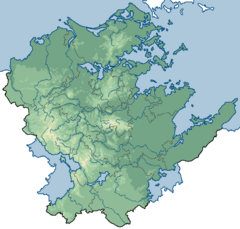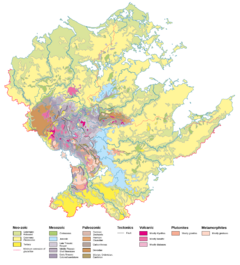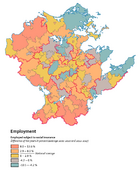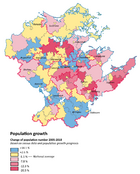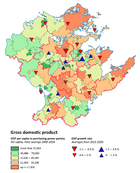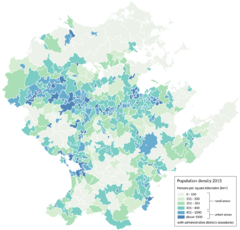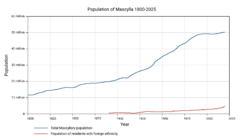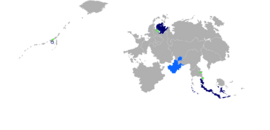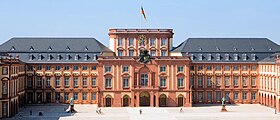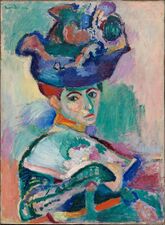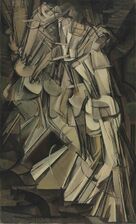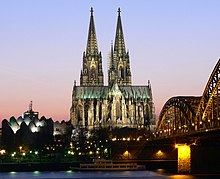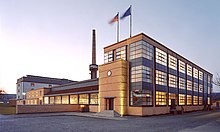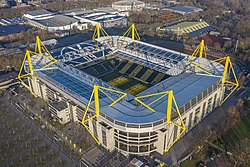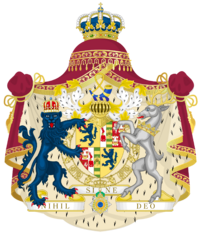Mascylla: Difference between revisions
No edit summary |
|||
| Line 130: | Line 130: | ||
==Etymology== | ==Etymology== | ||
==History== | ==History== | ||
{{main|History of Mascylla}} | |||
===Prehistory=== | ===Prehistory=== | ||
[[File:Nebra Scheibe.jpg|210px|thumb|right|The Sky Disc of Halie, an astronomical tool and religious object from the {{wp|Bronze Age}}]] | [[File:Nebra Scheibe.jpg|210px|thumb|right|The Sky Disc of Halie, an astronomical tool and religious object from the {{wp|Bronze Age}}]] | ||
Revision as of 12:28, 5 November 2022
This article is incomplete because it is pending further input from participants, or it is a work-in-progress by one author. Please comment on this article's talk page to share your input, comments and questions. Note: To contribute to this article, you may need to seek help from the author(s) of this page. |
Crowned Republic of Mascylla Gekrönte Republik Maskillien (Hesurian) | |
|---|---|
| Motto: "Nihil sine Deo" "Nothing without God" (Cambran) | |
| Anthem: "Geeint in Blut und Schwur" "United in Blood and Oath" | |
 Location of Mascylla (dark green) in Berea (dark grey and green) | |
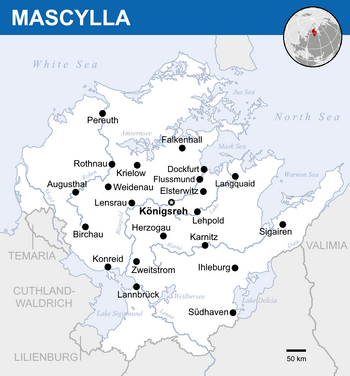 | |
| Capital | Königsreh |
| Largest city | Flussmund |
| Official languages | Hesurian |
| Recognised national languages | Cuthish, Waldish, Falian, Warnoan |
| Ethnic groups | 84.2% Mascyllary 10.5% other Telmerian 3.0% Black 2.3% Other |
| Demonym(s) | Mascyllary |
| Government | Federal parliamentary constitutional monarchy |
• Queen | Dorothea I |
| Thomas Falkner | |
| Egon Weidmann | |
| Walther Steintz | |
| Legislature | Parliament |
| Reichssenat | |
| Reichsrat | |
| Establishment | |
• Congress of Rehnern | 20 December 1757 |
| 4 September 1789—29 March 1793 | |
• Treaty of Langquaid signed | 18 May 1793 |
• Coronation of Lukas I | 23 May 1793 |
| 10 May 1923—22 January 1924 | |
• Current constitution adopted | 24 January 1924 |
• Coronation of Maximilian I | 5 March 1924 |
| Area | |
• Total | 711,482.6 km2 (274,705.0 sq mi) |
• Water (%) | 2.1% |
| Population | |
• 2019 estimate | |
• 2018 census | |
• Density | 125.1/km2 (324.0/sq mi) |
| GDP (PPP) | 2018 estimate |
• Total | |
• Per capita | |
| GDP (nominal) | 2018 estimate |
• Total | |
• Per capita | |
| Gini (2017) | low |
| HDI (2016) | very high |
| Currency | Mascyllary Karning (MKN, Ӄ) |
| Date format | DD/MM/YYYY |
| Driving side | right |
| Calling code | +47 |
| Internet TLD | .mc |
Mascylla (Hesurian: Maskillien), officially the Crowned Republic of Mascylla (Hesurian: Gekrönte Republik Maskillien) and rarely referred to as Mascillia, is a sovereign state on the Telmerian peninsula in northern Berea. It is bound to the west by Temaria, Lilienburg and Lake Sigismund, to the south by Cuthland-Waldrich and X, to the east by Valimia, and to the north by the North Sea and White Sea, with additional maritime borders with X to the north and Norden to the west. Königsreh is the country's capital, and with Flussmund as the most populous city are the two main cultural and economic centres of Mascylla; other major cities and urban areas include Langquaid, Augusthal, Lannbrück, Dockfurt, Karnitz, Weidenau and Konreid. With a population of approximately 89 million inhabitants as of 2018 and a territorial area of 711,482.6 km2 (247,705.1 sq mi), Mascylla is both the second-most populous and second-largest country in Telmeria after Valimia.
Mascylla is a federal parliamentary constitutional monarchy since its formal establishment in 1793. Current monarch since 2015 and the second female head of state in Mascylla's history is Dorothea I, while Thomas Falkner is elected head of government as Prime Minister since 2016. The constitution adopted in 1924 determines the separation of power is exercised by the country's Reichsrat and Reichssenat, the Kronenrat, formally by the ruling Monarch, and the High Court.
The area of what is now Mascylla was originally inhabited by a collection of Telmerian tribes, most notably the Therunds (Terunder), Falians (Fahlier), Aldens (Aldier) and Adhuins (Adhuiner) since classical antiquity. Following ill-fated attempts by the Cambran Empire to expand northward beyond modern-day Dulebia and its subsequent collapse in the aftermath of the Migration Period by 300 AD, the newly founded Albarian Kingdom annexed southern Mascylla while introducing Cambran innovations and customs to the region and developing a distinctive culture and language as the basis for modern Mascyllary culture. The presence of the Albarians prompted the slow creation of duchies and states from the Mascyllary tribes, and by 1000 AD most of Mascylla had been organized into a patchwork of petty kingdoms and duchies. Soon after, religious disputes and a prolonged series of dynastic disputes dominated Mascyllary politics in the Middle Ages, increasingly influenced by growing predecessors to the First Cuthish Empire and Loxstedt-Hoeveden Monarchy.
After the Adwhinish Wars and War of Kalaphay Succession in 1569 and 1603 respectively, two nations had emerged as regional powers, Aldia and Adwhin, vying for hegemony over the remaining Mascyllary states, with Aldia rapidly rising with a colonial empire it had acquired from Cuthland in the 1700s. The hostilities between both nations began to grow and, following the gradual dwindling of power of the Cuthish Empire in the latter 18th century that left a power vacuum in Mascylla's central provinces, three consecutive wars of unification were fought in the 1740s, 1760s and 1770s respectively. The epitome of violence would be reached in the War of the Five Kings from 1789 to 1793, with Aldia, leading a confederacy of states against Adwhin and ultimately emerging victorious. The subsequent Treaty of Langquaid negotiated the unification of Mascylla into a nation state with a continuation of the Aldian monarchy through Lukas I at its helm. The collapse of Cuthland and its slow periods of partition enabled Mascylla to vastly expand its Berean as well as Pamiran and Alvinian influence. Moreover, Mascyllary culture and commerce flourished by the turn of the 19th century, and the Aldian colonial system expanded into a global colonial empire that was the second largest by the 1830s. However, with the rise of the Second Cuthish Empire under Edwin III and following the Second Cutho-Mascyllary War (1839–41), Mascylla was utterly defeated and forced to cede pre-1758 Cuthish territories in Mascylla as well as a portion of its colonial possessions. The ensuing antagonization by the Mascyllary populous and the mutual hateship between both countries that had developed over the last two hundred years was a decisive factor in the causing of the Great War (1911–16). As a major participant and ultimately victor of the war with the Armala Coalition, it set the terms of peace, crippling Cuthland's military, economy and territorial extent, as well as reshaping the geopolitical order through the establishment of the Assembly of Nations in 1917. War-torn conservative Mascylla however succumbed to increasing calls for reform by the worker class, with the Mascyllary Revolution overthrowing the to this point de facto absolute monarchy and instituting a democratic republic with a constitutionally regulated monarch in 1924. An unprecedented economic boom in the 1920s and 1930s quickly recovered the damaged economy while solidifying the recently introduced democracy.
The enmities left by the Great War proved to be pivotal in the later course of the 20th century, when a re-organized Cuthland leading the Mageiros League and X rivaled the western democratic nations united by the BDTA after 1944. While Mascylla kept clinging onto its colonial possessions, the Melasian Crisis from 1941 to 1943 triggered the slow decolonization of its empire as well as the beginning of the Great Game (1944–1990). The 1960s and 1970s saw civil unrest and dissatisfaction with the country's policies, and additional terrorist movements and scandals further coalesced into a national insurgency, culminating in the July 20 1991 terrorist attacks. After numerous attempts of reconciliation by the democratic and communist blocs and following the 1987 stock crash and financial crisis, the X collapsed, leaving Cuthland and Mascylla as the two remaining rivals of the former Great Game. Recent reapproachment with post-communist states beginning in the 1990s however kept diplomatic tensions between the two at bay.
Mascylla today retains its political, cultural and economic power amassed in the 19th and 20th centuries. As the single largest economy by nominal GDP and second-largest by PPP, Mascylla is a highly developed country. It additionally ranks highly in rankings of human development, education, political and personal freedom, healthcare, life expectancy and economic competitiveness. Generally considered to be one of the world's great powers, it is a permanent member state of the Assembly of Nations Security Council and recognized country possessing nuclear weapons. It is a member of the Assembly of Nations, BDTA, Telmerian Union, and ECDF.
Etymology
History
Prehistory

The oldest evidence of the presence of the species Homo on Mascyllary territory date back atleast 500,000 years, and permanent presence to the south of the country is exptected to have begun 390,000 years ago. Homo geisahlensis is named after the city close to the site of its discovery. The atleast 200,000 years old Storßener Speere und Messer (Storßen Spears and Knifes) are the oldest entirely preserved hunting tools of humans yet discovered and marked a radical shift in the understanding of neolithic social development in the 1990s. The arrival of Homo sapiens, the anatomically modern human, having immigrated from Caphtora, marked the sudden dissapearance of all humans in Telmeria 14,000 years ago, though recent studies suggest all human species had joint descendants; this era also saw the zenith of the Upper Paleolithic revolution.
Coming from the Middle East and migrating through Dulebia to Telmeria, Neolithic farmers with their domesticated animals and plants slowly displaced the hunters and gatherers of the Mesolithic period in southern Mascylla by 5,500 BC. The cultures of hunters, collectors and fishermen to the north of the country remained resilient, but ultimately adopted the methods of the now sedentary, agricultural Western Linear Pottery cultures to the south in approximately 3,800 BC. With over 500 years of delay, the Bronze Age in Mascylla started 4,700 years ago and produced a wide range of artifacts and tools, most famously the Sky Disc of Halie discovered in 1990. The begin of the X period in 2000 BC marked the gradual end of Proto-Dentrian inhabitation and the rise of iron as the preferred working material. By 600 BC, the first considered modern Hesurianic cultures had already formed in northern Mascylla, and towns such as Falkenhall, Dalbeck, Rothnau, Bützow and Augusthal became the oldest continuously inhabited settlements in Mascylla. Ancient authors first used "Hesurians" as a ethnographic collective term in the 1st century BC.
Middle Ages
Early modern period
Mascyllary Kingdom
Crowned Republic
Geography
Mascylla is situated in the north of the Telmerian peninsula of the Berean continent, being bordered by X to the north, Valimia to the east, X to the southeast, X to the south, Lilienburg to the south-southwest, and Temaria and Cuthland-Waldrich to the west. It is furthermore bounded by Lake Sigismund to the southwest, the White Sea to the northwest and north, the Hallerweg strait in the north dividing the Jusland peninsula from X, the North Sea to the north-east, and Lake Decia to the southeast. The territorial extent of Mascylla covers an area of 711,482.6 km2 (or 247,705.1 sq mi), 2.1% or 14,941.1 km2 (5,768.8 sq mi) of which are areas of water; this makes Mascylla the largest country by size in Telmeria (excluding Dulebia and Valimia) and the Xth largest in the world. The country also encompasses overseas territories around the world, the largest of which by land area and population being Akawhk in Alvinia.
Its most notable feature is the abundance of diverse topographical and geological assets having been amassed throughout its turbulent geographical history. The Weißenhaupt mountains in the west of the country are the highest elevated areas of Mascylla, with the Schneespeer (at 2,597 metres or 8,520 feet) as its peak, while numerous collections of mountains and small ranges dot the central highlands region of Mascylla. The coastal areas are dominated by two low-lying agrarable and lightly forested plains, collectively the Eastern Mascyllary Plain to the east and the Fanian Plain in the north-west.
These regions are traversed by some of Telmeria's longest and major rivers, including the Blaugold, Mogd, Lahr, Warne, Rohrn and Lanne, and feature an abundance of waterways and lakes, the most notably of which Lake Sigismund (Sigismundmeer), the Welbernsee, Lake Decia (Delchsesee) and the Amsernsee. Due to its geological activity and diverse landscape, Mascylla is a deposit for numerous natural resources and biodiverse habitats.
Topography and geology
Its topographic outline is distinctive enough to be divided into three major regions—that of the Fanian Plain, Eastern Mascyllary Plain and Central Mountains massif. The central regions of Mascylla feature rugged and a patternless cluster of highlands, small mountaineous ranges and hillside, predominantly formed through ancient volcanic processes caused by the creation of the X mountains to the south of Mascylla and Telmeria, and the recent geologic development of the Cuthish Rift Valley to the west. Tectonic instability following the irregular collision of the Pamiran with the Dentro-Telmerian Plate some 42 million years ago fractured its central areas and allowed for short-lived volcanic activity that created numerous small volcanoes and uplifted large areas. Ultimately, this first phase of mountain building came to a halt 30 million years ago, when the collision and creation of the Ejeva Mountains stopped as well. However, the triggered fracturing gravely destabilized the entire plate, and the Cuthish Rift Valley formed from substantial crust thinning and the establishment of a graben along the foreland basin of the too recently formed Dentrian Mountains, causing further isolated volcanic activity and the uplift of its eastern rift flank, building the present-day Weißenhaupt and Hohnern mountains 28 million years ago. As a consequence of this geological activity, the ancient Telmerian Lake was drained and transformed into the Eastern Mascyllary Plain, while the Meinhard central massif was carved out from basalt deposits through the first initial volcanic phase.
While Mascylla's major topographic makeup is geologically young in its development, the massif on which it sits on was created nearly a billion years ago, and some of its heavily eroded and almost decimated mountains still exist, such as the linear hill and mountain ranges of Jusland (the Farstwald and Schwesengebirge) or the Meinhard massif, speculated to have originated from a magma plume submerged and active 260 million years ago, and later on uplifted with the creation of the X. Its bedrock is largely covered in younger volcanic materials and layers which protected it from aggressive erosion, and was geologically only recently resurfaced. This process is the only one in Mascylla to be an ongoing activity, and in tandem with the Cuthish Rift Valley, the cause for a number of historical earthquakes and small-scale volcanic eruptions as recently as 300 years ago.
During the last ice age, Mascylla was substantially covered by a glacier shield atleast 500 metres thick. This resulted in the depressions of today's Fanian and Eastern Mascyllary Plain, while heavily eroding away much of the mountains's previous material and mass. When global temperatures rose again, the ice cover melted away and released enourmous amounts of fresh water, filling the low-lying areas of the Cuthish Rift Valley and eventually forming Lake Sigismund as a glacial lake. The steep canyons and river valleys of the Central Mountains can also be attributed to the sudden heavy erosion experienced shortly after the Pleistocene ice age. The sediments of the mountains carried away by massive rivers eventually culminated as huge sandy deltas and marshlands, over time amassing and draining large swaths of previous shallow waters. As a result, large flat plains were created that today constitute Mascylla's low-lying coastal areas and their fertility.
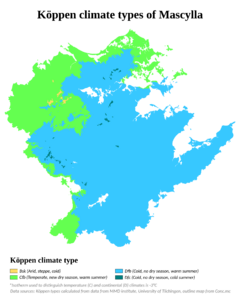
Climate
Mascylla is entirely situated within the temperate climate zone of Telmeria in the planet's westerlies zone and on a transitional area between the oceanic climate of Dentria and western Berea and the continental climate of Pamira. The climate of Mascylla is also influenced by the X Stream which is responsible for unusually high annual temperature averages at such a local latitude, supplying Mascylla and Telmeria with mostly wet and mild oceanic air. The influence of the Agric Ocean decreases significantly when moving from west to east. A maritime climate with minor temperature differences between winter and summer is found along the coastlines, the adjacent hinterland and areas up to the Lensrau Basin and Unterelpser Wald foreland, while seasonal temperature fluctuations increase when travelling southward to Holnia and Adwhin. However, major climatic differences also occur due to the country's obstructive and rugged topographical relief, which makes the passage of warm and cold air especially in the central regions of Mascylla difficult; while valleys and lowlands such as the Blaugold Valley and Dahle Valley allow for cold air to leave the mountaineous areas and warm air to highten its average temperatures, most areas and ranges remain generally more influenced by continental weather patterns than the geographically closer maritime climate.
The annual average temperature, when taken into account the national measurements of 1934–2000, is approximately 10.6 °C, and the national amount of precipitation estimated at 596.8 mm. While Mascylla enjoys much of the calibrating and controlling meteorological effects of large bodies of water, it has witnessed multiple extreme weather phenomena. The highest temperature ever on record and validified by the Mascyllary Meteorological Service (MMD) was 37.4 °C on 10 August 2019 in Sonthofen in Gotia, while the coldest temperature measured in Mascylla was at –22.5 °C on 19 January 1935 recorded in Munstborn, Adwhin. Natural meteorological hazards of Mascylla include forest fires such as the Thulba Fire of 2019, windstorms (called Orkane) such as Orkan Ariadne in 1998 or Orkan Lothar in 2006 and thunderstorms, floodings, storm surges, and landslides.
| Climate data for Königsreh (Schönhoch), normals 1975–present, extremes 1950–present | |||||||||||||
|---|---|---|---|---|---|---|---|---|---|---|---|---|---|
| Month | Jan | Feb | Mar | Apr | May | Jun | Jul | Aug | Sep | Oct | Nov | Dec | Year |
| Record high °C (°F) | 15.5 (59.9) |
17.0 (62.6) |
25.3 (77.5) |
28.9 (84.0) |
32.4 (90.3) |
34.9 (94.8) |
35.1 (95.2) |
37.4 (99.3) |
32.8 (91.0) |
27.2 (81.0) |
21.1 (70.0) |
14.0 (57.2) |
37.4 (99.3) |
| Average high °C (°F) | 6.9 (44.4) |
8.7 (47.7) |
10.0 (50.0) |
12.2 (54.0) |
17.6 (63.7) |
19.1 (66.4) |
24.8 (76.6) |
26.4 (79.5) |
21.7 (71.1) |
19.5 (67.1) |
12.5 (54.5) |
5.7 (42.3) |
15.4 (59.7) |
| Daily mean °C (°F) | 1.8 (35.2) |
2.3 (36.1) |
5.3 (41.5) |
11.0 (51.8) |
14.1 (57.4) |
16.9 (62.4) |
18.4 (65.1) |
20.2 (68.4) |
16.6 (61.9) |
9.4 (48.9) |
6.6 (43.9) |
3.7 (38.7) |
10.5 (50.9) |
| Average low °C (°F) | −0.7 (30.7) |
−0.2 (31.6) |
1.1 (34.0) |
4.6 (40.3) |
7.2 (45.0) |
10.4 (50.7) |
13.8 (56.8) |
15.0 (59.0) |
12.3 (54.1) |
8.8 (47.8) |
3.4 (38.1) |
1.2 (34.2) |
6.4 (43.5) |
| Record low °C (°F) | −22.5 (−8.5) |
−16.8 (1.8) |
−9.9 (14.2) |
−5.3 (22.5) |
−4 (25) |
1.7 (35.1) |
3.3 (37.9) |
6.5 (43.7) |
2.9 (37.2) |
−1.6 (29.1) |
−13.7 (7.3) |
−20.2 (−4.4) |
−22.5 (−8.5) |
| Average precipitation mm (inches) | 47.3 (1.86) |
40.5 (1.59) |
39.7 (1.56) |
36.0 (1.42) |
58.8 (2.31) |
70.1 (2.76) |
62.1 (2.44) |
59.2 (2.33) |
86.9 (3.42) |
31.3 (1.23) |
26.9 (1.06) |
38.0 (1.50) |
596.8 (23.50) |
| Average snowy days | 13 | 9 | 7 | 2 | 0 | 0 | 0 | 0 | 1 | 4 | 12 | 18 | 66 |
| Mean monthly sunshine hours | 61.7 | 77.6 | 119.4 | 165.6 | 228.1 | 236.9 | 240.3 | 216.2 | 160.8 | 119.4 | 63.5 | 57.3 | 1,746.8 |
| Average ultraviolet index | 1 | 1 | 3 | 4 | 6 | 6 | 6 | 6 | 4 | 2 | 1 | 1 | 3 |
| Source: MMD and MaskData | |||||||||||||
Biodiversity and environment
The biological territory of Mascylla lies predominantly in the temperate climate zone and its natural vegetation marks a distinct transformation from an oceanic climate to a continental climate. The flora of the country without human interaction is mostly constituted by deciduous forests of beeches and oaks and conifer forests of spruces and pines, excluding unfertile and arid areas such as mountain summits, heaths, moorlands and alpine und subalpine highlands, which are largely free of vegetation and colder in their climates. Locally, the flora in Mascylla exhibits a large diversitification due to local factors of the terrain and mesoclimatic location, which resulted in large numbers of different species of ferns, flowers, fungi, and mosses.
Around 45,000 species of animals are identified and varified to live in Mascylla, which in comparison to other Berean ecological areas makes it a rather less diverse area. Native wild mammals of Mascylla include deers such as the roe deer, wild boars, foxes, martens and lynxes; birds of Mascylla are for example the osprey, white-tailed eagle and falcon, while maritime species include seals, certain whales and amphibians. Beavers and otters are rather rare inhabitants of rivers and lakes, albeit with a growing population. Dense and growing human populations throughout history led to the devastation and extinction of various animals such as the wisent, native salmon, brown bear, wolf and moose, though recent efforts were successful in resettling populations of them in protected areas.
As of 2017, 29% of Mascylla's area was covered in forests and more than half of the entire area, at 52%, was devoted to agriculture, two-thirds used for pastures and greenlands and the remainder for actual agricultural activities. The protection and preservation of nature is defined by the Constitution as a public duty and designated policy target; ecological protection is served and guaranteed through 20 national parks, 24 biosphere reserves, 111 nature parks and thousands of nature protection areas, landscape protection areas and natural memorials.
Politics
Government
Mascylla is a federal parliamentary representative democracy formally governed by a constitutional monarchy, as codified and set by the its constitution. Exercising the separation of powers, the political system of the country is divded into the executive, legislative and judiciary, each controlled by a separate institution. Formally and de jure, the Monarch of Mascylla is the head of the executive branch and therefore head of state, ceremonial commander-in-chief of the armed forces in peacetime and most influential political instance in Mascyllary politics. However, since 1924 these powers are primarly vested in ceremonial and representative responsibilities and duties, and largely held by the Prime Minister, who serves as the head of government and exercises de facto executive power. The Prime Minister is elected directly by the public, and formally approved by the Monarch if he or she is able to wield the confidence of parliament through a single party majority or coalition government. The ministers of the cabinet are then proposed by the Prime Minister, who are in turn either approved or rejected by the Reichsrat. Current Prime Ministe since 2016 is Thomas Falkner of the RU and ruling Monarch since 2005 is Queen Dorothea I.
The political system is laid out by the frameworks of the Constitution (Reichsverfassung) and Crown Law (Krongesetz) established in 1793 and 1800 respectively. Essential concepts of the system, such as the federal structure, respect to human rights, the rule of law and democratic basis were officially added in 1924 and are protected by a status of perpetual validity. Direct democracy is supported through the availability of protests, referenda, a multi-party system and accountance of the government, and guaranteed freedoms of expression, assembly, and universal suffrage beginning at age 18.
The legislative is composed of two institutions, the Reichsrat and Reichssenat, who together wield legislative power in proposing and deciding on law proposals and amendments. While the Reichssenat is not an official institution established by either document, it was preserved since the country's unification in 1793. The Reichsrat is directly elected using the system of mixed-member proportional representation, while the Reichssenat as the representative body of Mascylla's federal states and free cities is appointed by the individual state governments. The legislative chambers have a wide set of political options and powers, and are overseen by the President of the Reichssenat (Präsident des Reichssenates), currently Egon Weidmann, and the Prime Speaker of the Reichsrat (Oberster Sprecher des Reichsrates), currently Walther Steintz, coming second and fourth on the oder of precedence, respectively. The judiciary of the state is embodied in the High Court of the Realm (Hohes Gericht des Reiches), led by Highest Judge Linus Pretschgen, being the official source of law of the country and guarantor and protector of the constitution.
In Mascylla's political history, the Centre Party (preceeding the Rehunion), Social Democratic Party and National Democrats have been the dominant parties, with almost every Prime Minister to date being a member of either party. Smaller parties still retain significant power however, most notably the Liberal Party who successfully navigated to enter coalition governments throughout the 20th century and maintain two Prime Ministers; the other small People's Party, The Greens, and Adwhinish Citizens' Party, while small, also frequently partake in the political discourse and are staples of the legislative. Almost every goverment was a coalition government however, and much of the smaller parties oriented to the larger parties, who maintain catch-all blocs in hopes to better negotiate a coalition government contract with another major party bloc.
Administrative divisions
The federal system of the Crowned Republic is represented and exercised through its 22 member states, which are officially referred to as Länder ('States') or Reichsländer ('Imperial States'). The city states are individually called Freie Städte or Freie Reichsstädte ('Free Cities' or 'Free Imperial Cities') depending on the historical and economic development of the cities as free entities, and encompass the states of Kronlande, interchangibly used with the city name Königsreh, Flussmund, Pereuth and Langquaid. Kronlande, Pereuth and Langquaid are each governed as unified municipalities (Einheitsgemeinden), while Flussmund, as an exception, is composed of two municipalities of Flussmund itself and Dockfurt. However, as opposed to other federal states, Mascylla does not have a territory of direct government control such as a capital district.
The states and free cities make up the most significant devolutionary subjects of the Mascyllary federal system, however they are subdivided into municipalities (Gemeinden) as the smallest unit of administrations. They are, excluding the free city states and independent cities of the states, each summarized into districts (Landkreise), depending on the municipality's population and location.
Districts and municipalities are subject to the individual laws of the states, and therefore considerably variable, however in compliance with the supreme Constitution. Representative councils of the municipalities are directly voted by the public, and enact local laws and decisions based on the larger state's actions and legal situation; while each subject or level maintains bodies of delegates, solely the legislature of the state and its government is politically relevant to the entire country, seated in the state's capital (Landeshauptstadt).
| Map | State | Capital city | Largest city | Population (December 2018) | |
|---|---|---|---|---|---|
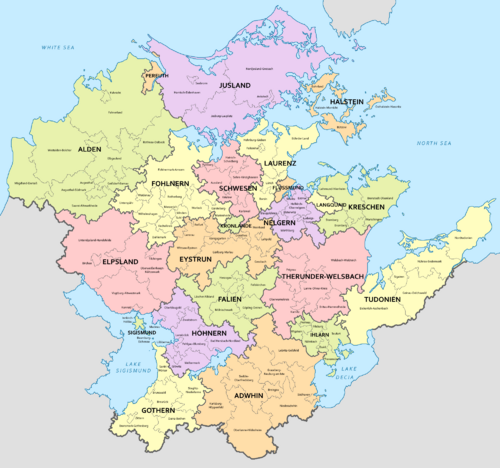 |
Subdivision | ||||
| Breisgau | Südhaven | 5,826,004 | |||
| Augusthal | Augusthal | 4,924,217 | |||
| Birchau | Konreid | 841,107 | |||
| Lehpold | Lensrau | 5,208,624 | |||
| Herzogau | Herzogau | 1,440,506 | |||
| — | — | 2,061,837 | |||
| Weidenau | Weidenau | 5,246,111 | |||
| Zittern | Brunswald | 674,696 | |||
| Bützow | Ankstedt | 535,282 | |||
| Lannbrück | Lannbrück | 4,724,292 | |||
| Ihleburg | Ihleburg | 916,623 | |||
| Seebronn | Seebronn | 446,190 | |||
| Bromberg | Würthburg | 911,382 | |||
| Königsreh | — | 2,231,326 | |||
| — | — | 815,180 | |||
| Falkenhall | Falkenhall | 658,204 | |||
| Elsterwitz | Elsterwitz | 5,779,104 | |||
| — | — | 581,034 | |||
| Krielow | Pottburg | 603,226 | |||
| Innkirch | Innkirch | 498,192 | |||
| Karnitz | Karnitz | 3,644,524 | |||
| Sigairen | Sigairen | 704,675 | |||
| Königsreh | Flussmund | 48,972,336 | |||
Law and law enforcement

The Mascyllary judicial system is based on the Mascyllary law developed from Mascyllary law of previous tribal communities and early versions of a modern judiciary in documents of the Middle Ages, most significiantly the Welsbächisches Bürgerrecht and Fahner Recht, and a modified version of Cambran law embraced in the 12th century due to its precision, efficiency and versility. The Crowned Republic defines itself as a constitutional state, and therefore committs itself to base political actions on the sole rule of law that can only be regulated by the constitution of the country. Anybody who has their rights violated by public violence or action has the right to seek legal justice at a court. The judges are independent and obliege no limitations in their jurisdiction. The justice system is primarly exercised by the states' courts individualized for certain crimes and affairs and their severity, including the Amtsgericht (district court), Landgericht and Oberlandesgerichte (higher regional court). The highest court of the judicial system and the country's court of appeal for civil and crime-related cases as well as the constitutional court is that of the High Court of the Realm (Hohes Reichsgericht), while other courts are responsible for work-related (Arbeitsgericht des Reiches), political and administrative (Reichsverwaltungshof), social (Sozialgericht des Reiches) and financial cases (Reichsfinanzhof).
Generally, internal security is the responsibility of the individual states of Mascylla due to its federal nature. However, Mascylla instead opted to unify the state police forces into a centralized unit in 1800, today the Imperial Police (Reichspolizei). In turn, the Reichspolizei is separated into distinctive branches of specialization, including security police (Schutzpolizei), riot police (Bereitschafts- und Sonderpolizei), criminal police (Kriminalpolizei) and special forces (such as the Spezialoperationseinheit (SOE) and Mobileinsatzkommando (MEK). The protection of public order is also supported by the border protection police (Reichsgrenzschutzpolizei) which is responsible for border protection and anti-terror measures. Other institutions include the Reichskriminalamt used to investigate severe crimes, the Zolldienst, Zollfahndungsamt and Zollkriminalamt for customs enforcement. All of these agencies are subject to the Ministry of the Realm in close collaboration with the Ministry of Finance of the Realm.
Mascylla also maintains three separate intelligence services: the civil Dienst für strategische Aufklärung (DSA) gathers civil and military intel from abroad and processes them accordingly, the internal Agentur für Demokratieschutz (ADS) oversees the protection of the constitution and deterrence of espionage, and the Militärischer Abschirm- und Aufklärungsdienst (MAAD) of the Ministry of Defence of the Realm and Reichswehr respectively. Intelligence agencies do not have the enforcement authority as opposed to police forces and are subject to more guidelines and regulations by the civil authorities.
Foreign relations and policy

Mascylla, as a dominant political, economic and military world power, has established and often extensive relations with almost every country as part of its intricate foreign policy. Almost every country maintains an embassy in Königsreh and further consulates in other major Mascyllary cities; therefore Mascylla maintains a wide set of diplomatic missions to almost every other country on the planet as well. It hosts the headquarters of the Assembly of Nations located in Königsreh, and is a member state of the organization and permanent member of the Assembly of Nations Security Council, by which it maintains and ratifies its status as a recognized great power. It is a member of the Telmerian Union.
The country has played an influential role throughout much of modern Berea's history, beginning with its inception in the late 18th century. Culminating in the joint foundation of the Berean Defence Treaty Association (BDTA) of 1944, it has maintained a significantly strong relationship with Lavaria and extensive dialogue with Falland, after having collaborated and cooperated together during the Great Game and previously the Great War as political allies. Relations with Cuthland-Waldrich remain an integral part of Mascyllary foreign policy and historically played a significant role in Mascylla's development and policymaking. While antagonizing Cuthland as a major enemy of Mascylla repeatedly through the 20th century, it has promoted the foundation of a more centralized and unified Berean political, economic and security system, and due to economic interests and political goals, advocated for a political order of Interbereanism after the demise of the Great Game. As a result, Mascylla also established treaties with Temaria and Lilienburg to bolster its economic integrity with them, while also providing means of national defence and security needs; it has pushed numerous times to expand the project to other Telmerian countries in hopes of economic and political co-ordination and unification, coming to fruition with the Telmerian Union of the 1990s. Mascylla also maintained strong bilateral relations with its former colonies, most notably the recent reapproachment to Melasia, and continuously supplied economically or intervened in insurgencies in said colonies and generally minor states in Berea, Caphtora and Pamira around the world, such as X in X, while being repeatedly criticized for its reactionary foreign policy and interventionism.
Military

The Mascyllary Reichswehr is the military and paramilitary organization of Mascylla responsible for its external protection and military actions. It consists of the Streitkräfte, namely the Mascyllary Army (Reichsheer), the Mascyllary Navy (Marine) and Mascyllary Air Force (Luftheer), and the Zivilverwaltung of the Reichswehr Joint Medial Services (Reichwehrmedizinbasis) and Joint Support Services (Streitkräftebasis), fulfilling the role of the civil counterpart, non-combat support branch and acting police forces of the military. Combined, the Reichswehr deploys some 167,300 active duty soldiers and 329,700 reserve personnel as of 2017, making it one of the largest armed forces in the world and the second largest in Telmeria proper behind the Cuthish military; it has formally suspended the use of conscription in 2002. Mascylla's annual military expenditure was at Ӄ60.2 billion (US$46.8 billion), or 2.2% of its GDP, making it the second-largest global military spender, only behind Kodesh. The Reichswehr is overseen by the Ministry of Defence of the Realm, and while the Monarch remains the ceremonial commander-in-chief in peacetime, the Prime Minister wields executive power in essence.

Mascylla's military position is demonstrated by its status as a permanent member state of the Assembly of Nations Security Council and recognized nuclear weapons state since the testing of its first nuclear device in 1943, having both ratified and signed the Comprehensive Nuclear-Test-Ban Treaty in 1990 and the Birchau Nuclear Non-Proliferation Treaty in 1984. Its current nuclear weapons stockpile (as of 2020) encompasses 390 active warheads. Its nuclear strategy and deterrence relies on its nuclear triad capability: it maintains a fleet of 19 Pritnitz-class submarines equipped and purposed for submarine-launched ballistic missiles (SLBMs), long-range strategic aircraft, such as AB-2 Donnerschlag and ABT-1 Geist bombers, capable of carrying gravity bombs, air-to-ground missiles, and cruise missiles with nuclear warheads, and silo-based ICBMs and MRBMs capable of delivering multiple nuclear weapons or one, respectively.
Mascylla's military is supported by a large complex of civil companies and therefore stimulates one of the largest arms and aerospace industries in the world. It has also collaborated on a number of international projects with other countries, most notably the other BDTA member states and Dulebia, but generally prefers the use of domestically produced arms and equipment as opposed to foreign import. Major defense contractors such as Schütze Gneisau, Wiesar or Albatross frequently partner with the Reichswehr in weapons development, and are among the largest arms sellers worldwide due to their availability to export most of the arsenal's designs.
Economy

With a nominal gross domestic product (GDP) of $4.796 trillion in 2018, the economy of Mascylla is the single largest one in Berea and the world at large, and the second-largest one measured by PPP. Mascylla is considered to be a developed country with the fifth-highest Human Development Index of the world and boasting one of the largest rates of nominal GDP per capita in any country; it also ranks third in the Global Competitiveness Index of 2019. Mascylla's economic viability is mainly derived from its policy model of numerous small and medium-sized enterprises, called Mittelstand, which are especially effective and moreoften world market leaders in specialised industrial sectors. Furthermore, the human potential of Mascylla with sufficient education and a large innovation culture are seen as integral to the success of the Mascyllary economy. Mascylla's economy is defined as a highly developed and free-market-oriented social market economy. The entirety of economic productivity is brought about by 1.1% in the primary industrial (agriculture), 38.4% in the secondary (industry) and 60.5% in the tertiary (services) sectors. Mascylla employed its largest labour force of 74.826 million people in 2017, or 84.1% of the population, in its history; its unemployment rate was estimated at 15.9% in 2017.
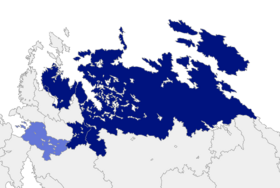
While Mascylla has access to large resource deposits (including coal, industrially relevant minerals such as silver, iron, zinc and copper, and salts) and a long history of mining, it is crucially dependant on the import of resources and energy assets from abroad. The most competitive sectors of the Mascyllary industry are considered to be the automotive, aerospace, electronic, heavy machinery and chemical sectors. Financial services such as banking and insurance managing are also globally significant, with Flussmund in particular serving as an international financial centre. The most important trading partners of Mascylla in 2016 were Yudong at a trading volume of $251.37 billion, Lavaria with $246.60 billion, Valimia with $226.71 billion, and Sarrac with $119.28 billion. The value of all exports of goods and services comprised 52% of the economic output in 2017, which makes Mascylla a highly globalised and export-oriented economy, although with potential to decline following global trade fluctuations, despite the economic growth of the recent decade being largely fueled by an increase in participating consumers.
Mascylla also serves as the mediator of the Telmerian Union, an economic area comprising Mascylla, Temaria, Lilienburg, Valimia and Valtriva (approximately 222 million people) to foster economic development, import and export relations, trade customs and currency policy. The Mascyllary national currency is the Karning (MKӃ, Ӄ) and its exchange rate and policy is directed by the national Great Bank of Mascylla in Flussmund. The Karning is among the most traded currencies by value and important reserve currencies in the world.
Of the world's 500 largest stock-market-listed companies measured by revenue in 2014, 94 of which are headquarted in Mascylla. 31 major Mascylla-based companies are included in the MAIX, the prime Mascyllary stock market index which is operated by the Flussmund and Königsreh Stock Exchanges, in order to coordinate market economic and company-related affairs. Major, well-known and internationally popular Mascyllary companies and brands include EdgeCartz, Baumbach, Grainer and Damo in the automotive industry, Reuthers, Koldmeier, Albatross, Magnall, SPCF and AGAtechnik as electronics, chemistry and technology producers, Bunde and Königliche Bank as insurance and banking comglomerates, the retailer BIEK, petrochemical producer Shale PetroChem, transport companies MKH and Maskillische Post, Mask Telekom, software and computer manufacturers DAP, Heiders, WohlneMKS and IBA Systeme, and media producers such as RSUGlobal, Prisma, BärtleKrenz, and ANB.
Agriculture
While the agricultural industry gradually diminished in their importance to the national economy, partaking only 1.1% of economic business in 2015, it is still considered internationally relevant in generating a wide array of products, being the fourth-largest exporter of agricultural products in Berea. The domestic agricultural industry is extremely productive in that it is able to sustain and cover more than 85% of the Mascyllary population's needs for food in 2019, mainly due to extensive fertile soils in northern and eastern Mascylla and sophisticated modern technology used in agriculture.
Principal agricultural exports of Mascylla include products of lifestock, including poultry, beef and pork, dairy products, wheat, potatoes, sugar beets, rye, cabbages, and fruit. Processed food such as variations of cheese and bread are also important, and form staples of Mascyllary cuisine, while to a lesser extent domestically grown wine, citrus fruits and legumes are also consumed and exported. Beer is a historically relevant, traditional and widely popular beverage, and many beers brewn in Mascylla are known worldwide.
Tourism

Mascylla is the second-most visited country in the world as of 2015, with a total of 39.7 million international arrivals and overnight stays of tourists. Tourism as an economic sector made a considerable contribution to the national economy, generating a revenue of $446.75 billion, or 9.4% of Mascylla's GDP in 2019. It is also an important source of employment in urban areas and by a smaller margin in rural areas of frequent availability to tourists. Approximately 3,500 of the 10,162 town and villageships of Mascylla are registered in some form of tourist agency, and 260 of them are recognized spas and seaside resorts. 4,281 museums, 204 theatres, 18 amusement parks, 32,100 tennis courts, 711 golf courses, more than 175,000 kilometres of hike trails and 20,000 kilometres of biking ways, and numerous special thematic routes (Themenstraßen) are all available and accessible to tourism activities.
The country is host to a number of well-known cultural, iconic and environmental tourist destinations, as well as 27 UPESCH World Heritage Sites, among the ten countries globally with the most protected sites. Königsreh and Flussmund are the leading tourist destinations of Mascylla, attracting up to 9.3 and 7.6 million tourists in 2010 respectively; the most popular sites are the Siegestor, Reichsrat and Kronenrat building, Königsreh Zoo (Zoologischer Park), Hohenehr palace, Sankt Lorenz Cathedral, and Reichsmuseum in Königsreh, and the Nielsenbrücke, Museum der Nationalen Künste, and Amelienburg palace in Flussmund. Other major tourist destination in Mascylla include the Augusthal Palace in Augusthal, Liechtenwald Palace in Lehpold, Sankt Weidemar Church in Breisgau, Cathedral of Langquaid, Alte Halle der Künste in Konreid, Prinzenwald park in Königsreh, Dameroper in Karnitz, the states of Jusland and Halstein for their beachsides and abundance in nature, and the Altstädte (old towns, city centres) of Eichenau, Konreid, Lübbernau, Augusthal, Breisgau, Ihleburg, Langquaid and Weidenau.
Mascylla is also a significant host of international economic and innovative exhibitions, particularly the cities of Lannbrück and Langquaid, colloquially called Messestädte ('fair cities'). The country is often viewed as the most valuable fair host worldwide, and its exhibitions, fairs and congresses considered to be trend-setters of global economic sectors, with more than 7.7 million visitors arriving in Mascylla for the 100 largest fairs alone in 2010.
Transport and infrastructure
Due to the dense human habitation and central role in regional and global economics, Mascylla witnesses large-scale traffic and needs for transport accesibility. Therefore it boasts an extensive network of roadways, waterways, railways and air-bound infrastructure. Mascylla has one of the densest and longest road network in the world, with more than 412,000 kilometres of navigable roads, and 8,707 kilometres of the nation's highway Autobahn network. International access by road is substantially guaranteed for every neighbouring state of Mascylla. As of 2020, 47.5 million passenger cars were registered in the country, while the total number of all motor vehicles and trailers accounted to roughly 62.4 million in the same year.
The railroad network of Mascylla is 543,726 kilometres long and is traversed daily by up to 40,000 passenger and cargo trains. The partially state-owned largest railroad company Gekrönte Bahn AG serves and oeprates a large number of trains, passengers and infrastructure components, but under growing competition with 204 other railroad companies seeking to balance out the economic preference of the GB and establish norms of a free market economy in the railroad transport sector. Most of the railroad infrastructure is maintained, operated and financed by the Ministry of Infrastructure of the Realm of the Mascyllary government since 1997. The network is used by regular and high speed trains, most notably the ILE and InterCity trains travelling at between 240 km/h (149 mph) to under 370 km/h (230 mph), providing expansive domestic and international rail connections. Confined urban underground rapid transit such as the U-Bahn, suburban transit such as the S-Bahn, light rail tramways (Straßenbahn) and omnibus services are all well developed in major Mascyllary cities.
462 airports and airfields were located throughout the country in 2010, one of the highest densities of runways per country in the world, which also makes Mascylla an active location of air travel. The Albert Polschnitz Airport in Königsreh was the largest airport in Mascylla in terms of passenger arrivals (at 40.1 million passengers) and third-largest by metric tons of cargo in 2011. Mascylla's flag carrier airline Maskillea Airlines operates from Albert Polschnitz Airport as well as Flussmund Lachsen Airport intercontinental connections, and numerous other airlines provide domestic and international flights as well. Due to Mascylla's dependancy on import and export, trade by sea is integral. Mascylla maintains a number of seaports, the largest of which by amount of cargo are Pereuth, Flussmund and Mogdburg, as well as a network of canals supported by the country's extensive natural waterway system, the most important traversible rivers being the Mogd, Rohrn, Blaugold, Warne and Lanne.
Energy

More than 576 TWh of primary energy was domestically generated by Mascylla in 2016, making it the fifth-largest producer of energy in the world and largest in Telmeria. Mascylla's primary energy consumption in the same year was estimated at 273.2 TWh, while Mascylla was also the fourth-largest global energy consumer between 2004 and 2010, and due to its inbalance between power generation and consumption also one of the world's largest importers of energy. Power supply was ensured by 491 companies with headquarters in Mascylla in 2010, with the largest company being LOE seated in Lannbrück, a partially state-owned enterprise which holds a probable monopoly status over Mascylla's energy market; it is also one the most important markets of traded electricity in Berea and the world.
Renewable energies comprised over 63% of gross generated energy, one of the highest numbers in the world, 34% of net generated energy, and 4.5% of fuel supplies. Other main energy providers for the national electric consumption include mainly nuclear power and dependable imported supplies of coal, petroleum and natural gas from more resource-intensive countries such as Valimia and Dulebia, which in particular operates a large Telmerian gas pipeline grid. Nuclear power stations generate a considerable amount of electricity, adding 9.1% to the national energy supply in 2014, though efforts to phase out nuclear power have been gradually introduced in the early 2000s. The national energy transformation policy, the Energiewende, provides for a gradual change towards rising the percentage of renewable energy supplying Mascylla to 70% by 2070 as well as drastically lowering the emission of greenhouse gasses by more than 85% until 2100. While partially successful, numerous critics put forward concerns of an insustainable deconstruction of present energy industrial sectors such as the petrochemical and mining industries, as well as significantly low attention to nuclear power advantages.
Science and technology
Mascylla is an internationally significant and renowned location of technology and science. Since the Industrial Revolution, Mascyllary scientists participated immensly in the foundation of modern science; especially the economic productivity of multiple industrial sectors and the transfer of knowledge to practical use proved pivotal in the scientific development of the Mascyllary academic field. Approximately 12% of all patents registered in 2015, or the second-highest amount worldwide, originated from Mascylla. Publications of scientific matters receive international acclaim and domestic public popularity; scientific journals published in Mascylla include Natur and Erkunder, while Mascylla as a research host produced more than 10% of the world's scientific research papers in 2019.
Institutions of research and science in Mascylla are embodied through universities (Universitäten), technical universities (Technische Universitäten) and universities of applied sciences (Fachhochschulen). Most of which are in public ownership and service, but their research activities are often financed by third parties such as the Maskillische Forschungsunion (MFU), foundations, companies, and other. The Carl Linnder University of Königsreh and the University of Lehpold remain one of the most renowned and prestigious universities in the world. Apart from the country's universities, a large number of research organizations are active across Mascylla and abroad, represented and coordinated through associations and councils in compliance with the Ministry of Education of the Realm and each university. the most famous of which include the Joseph Görche Society (Joseph-Görche-Gesellschaft) for basic research, the Wolbrecht Society (Wolbrecht-Gesellschaft) as the country's largest scientific society, and the Maximilian Nohrbach Society (Maximilian-Nohrbach-Gesellschaft) for applied research.
Numerous researchers and scientists from nearly all industrial and modern scientific fields come from Mascylla: more than 150 X Prize winners are assigned to the country. The Mascyllary Kingdom was considerably interested in the emergence and nuturing of its academic field, and encouraged researchers with national institutions and sufficient funding in order to raise awareness and prestige from foreign circles. Joseph Görche was pivotal to the foundation of theoretical physics and the understanding of electromagnetism, Conrad Ehrach discovered and studied x-rays, later named Ehrach radiation in his honor and today used for medical diagnostics and material examinations, and Johann Theodor Threu formulated important works of electromagnetic radiation, today indespensible for telecommunications and quantum physics. The efforts of Carl Eduard Edge, Adolf Baumbach, Johannes Mohren, and Ferninand Bürgel helped revolutionize transport with their early prototypes and inventions, and many of which became pioneers in the development and later popularization of the automotive, airplane and submarine. Figures such as Erhard Reuthers for his utilization of the dynamoelectric principle, Justus von Holtzbruch for the discovery of nuclear fission, the 18th century universal scholar Eduard Friedrich Lobrecht, Philipp Alexander von Hährnig as the principal naturalist and explorer of the early 19th century, mediciners and pioneer microbiologist Norbert Schenck, and sociologist and social theorist Egon Kolber are all renowned and influential scientists of early Mascylla.
During the Melasian Crisis, Mascylla and Falland cooperated in developing and successfully detonating a nuclear weapon, ushering in the Atomic Age. The invention of the transistor by Gottlieb Rieß marked the beginning of modern day electronics. Mascyllary spaceflight achieved decisive pioneer accomplishments in materials science, aeronautics and space sciences and together with international partners such as Falland and Dulebia performed numerous operations and projects, most notably Sigma 5 of the Sigma program which first landed humans on the Moon in 1980, and the operation of the Haller Base lunar research station on its surface until 2009; spaceflight activity also spawned the Mascyllary Aerial and Orbital Agency (MAOA) as a capable space agency and renowned rocketry engineers such as Emil Haller and Wernher Grätzge.
Demographics
Mascylla has a population of approximately 89.23 million according to its 2019 census estimate, thus making it the most populous country in Telmeria ahead of Cuthland with around 44 million inhabitants, the second-most populous in Berea and the sixth-most populous country in the world. Despite its population size, it stands at a relatively small population density of 125.1 people per square kilometre (323.9 per sq mi) and high rate of urbanisation. Being a developed country, Mascylla's average life expectancy at birth measures at around 80.05 years (79.72 years for men and 81.94 years for women) and a dampened fertility rate of 1.76 children per woman, below the required replacement rate of 2.1 children. Historically the rate of reproduction remained above-average with 2.49 children in the 1970s, but deteriorated significantly since then with a period of the death rate of Mascylla exceeding its birth rate and a slightly shrinking population between 1990 and 2010. However, Mascylla since then adovcated immigration to the country and introduced efforts to stimulate population growth; increased birth rates and migration numbers curbed the low fertility rate and supported population growth since 2010. Mascylla's population, like other developed countries, is aging as well: the average age is estimated at 41.8 years, making it the fourth oldest population in the world.
Most Mascyllary people are predominantly of Hesurianic origin, which make up approximately 81.4% of the population. However, Mascylla features a wide range of ethnic groups mainly attributed to either small minority groups in Mascylla proper, such as the Cuthish and Waldish to the west and south of the country, though often associated with the Hesurianic ethnic groups at large, Valimians to the east, and ethnic groups attributed to substantial immigration from countries formerly part of the Mascyllary colonial empire, namely Melasians and Cunuccans due to the lack of a pre-existing language barrier, or other countries in Caphtora and Pamira which has led to a large diversitification of the immigrant population in recent decades.
Mascylla is one of the most important immigration destinations in the world. In a 2017 census, 17.44 million people (or close to 19.6%) were either of immigrant or partially immigrant descent, and in 2015, 21% of all newborn children had atleast one parent born in a foreign country, and 12% atleast one born outside of Berea, including Mascylla's overseas territories. Immigration to Mascylla is a key factor in supporting its population growth and supply of work forces in light of its aging population, and Mascylla hosts the third-highest number of international migrants at about 10.04 million people.
Major cities
Mascylla is a highly urbanized country, with a disproportionate amount of larger cities as defined by the country's data census. Its largest cities include Flussmund (with 4,118,492 inhabitants), Königsreh (3,231,326), Langquaid (815,180), Augusthal (789,426), Lannbrück (615,337) and Pereuth (581,034), and features a number of large metropolitan areas summing up urban agglomerations, such as the Greater Flussmund region or the Rohrn-Klahr Region with populations exceeding up to 7 million inhabitants. Four states, referred to as Free Cities (Freie Städte or Freie Reichsstädte), encompass solely highly urban regions and administer the country's largest cities. Geographically, most urban regions are concentrated in the central regions of the country, branching out west and east respectively, with minor clusters along the Sigismund Corridor and Warne regions.
Largest cities or towns in Mascylla
2018 census | |||||||||
|---|---|---|---|---|---|---|---|---|---|
| Rank | State or Free City | Pop. | Rank | State or Free City | Pop. | ||||
 Flussmund  Königsreh |
1 | Flussmund | Flussmund | 4,118,492 | 11 | Breisgau | Adwhin | 281,614 |  Langquaid  Augusthal |
| 2 | Königsreh | Kronlande | 3,231,326 | 12 | Sigairen | Tudonia | 278,998 | ||
| 3 | Langquaid | Langquaid | 815,180 | 13 | Lensrau | Eustria | 252,040 | ||
| 4 | Augusthal | Aldia | 789,426 | 14 | Konreid | Elpsland | 242,443 | ||
| 5 | Lannbrück | Holnia | 615,337 | 15 | Herzogau | Falia | 240,725 | ||
| 6 | Pereuth | Pereuth | 581,034 | 16 | Ihleburg | Ihlarn | 216,268 | ||
| 7 | Karnitz | Therundy-Welsbach | 525,471 | 17 | Lehpold | Eustria | 173,117 | ||
| 8 | Südhaven | Adwhin | 442,438 | 18 | Elsterwitz | Nelgery | 170,362 | ||
| 9 | Weidenau | Folnery | 375,647 | 19 | Tilchingen | Elpsland | 168,050 | ||
| 10 | Dockfurt | Flussmund | 306,769 | 20 | Merzenich | Folnery | 159,181 | ||
Language
The most widely used and spread language in Mascylla is Hesurian (High Hesurian). It is the standard language of overregional media and is used as the accepted written language; Hesurian remains the predominantly spoken language in almost every region, while the transition of usage to Mascyllary Hesurian dialects is minor. As one of the country's official languages, Hesurian is the most important administrative language, though the acknowledgement of an administrative language is part of the states' individual cultural sovereignty, while the encompassing state only determines a language for official use and domestic duties. Upon request, it always remains possible to adapt any official document into a translation of a wished language. Historical national minorities include Waldish, Valimians, Warnish, and Temarians. Certain regional and minority languages can be used as official, administrative and court languages. The by deaf people used Mascyllary Sign Language (MGS) was recognized as a language following the introduction of the Behindertengleichstellungsverordnung (BGsV) in 2000.
Languages introduced to Mascylla by immigrants are numerous and often treated as "unofficial official languages." While the descendants of older migration waves have largely adapted to the linguistic environment of Mascylla, immigrants of previous decades, more often guest workers and refugees, still frequently use their mother language in their daily lives, most notably X. Other such widely used languages include Dulebian, introduced by a large diaspora of Dulebian Hesurian people and contingent refugees, Rovinian, Cuthish and X. The prioritized foreign language taught at public schools is Lavish, and the second foreign language is often Fallish, Cuthish or Cambran, more rarely Lyonian or Dulebian. Mascyllary citizens are thought to be multilingual, with 70% of citizens claiming to be able to communicate in atleast one language other than Hesurian.
Due to Mascylla's history, Hesurian is a widely recognized world language of business and culture and one of the world's most spoken languages as part of the legacy of the Mascyllary colonial empire of the 19th and 20th centuries, sharing the status as official language with three other countries. Hesurian-speaking countries and their inhabitants are referred to as hesurophon. Hesurian is taught as a foreign language at a large number of schools abroad and remains a significant global political, economic, cultural and social language.
Religion


Like the majority of Northern and Western Berea, Mascylla was significantly influenced by Semitar and Occidental theorems until the Late Middle Ages, and scientific and enlightened sociological models from the 18th century onward. The basis for early religious and cultural development were influences from Erytherian and Cambran culture, and X and Semitar traditions and practices that have mixed with Hesurianic cultures since the gradual Semitarization of Telmeria in the 5th to 8th centuries.
As a legally defined secular state, Mascylla guarantees freedom of religion as an individual constitutional right and institutional separation of church and state. Thus the religious view of the state is determined to be neutral and the right of self-determination for religious groups upheld. While the government refrains from recognizing any certain rights of a religious group, and these groups are expected to reject any interaction with politics, church and state rather act as partners: they maintain substantial ties in social, educational and cultural affairs, for example by kindergartens, schools, hospitals or retirenment homes overseen by religious actors but state-financed.
Approximately 54% of the total Mascyllary population were members of a Semitar confession: 26.4% Cambran Semitarism, mainly located in southern and western Mascylla, 22.8% Nordic Semitarism, and 5.2% Orthodox Semitarism and other Semitar churches. The number of worshippers is significantly smaller than the total number of church members; in 2015 around 2.3 million people, or 2.6% of the national population, attended a Semitar church service, while the number is overwhelmingly higher during religious holidays, doubling in total. More than 32% of the population are non-denominational and identify as atheist or agnostic, and another 2.8% adhere to minor sects, differenciating beliefs or other religions. In 2019, 4.4 million people identified as Muqallids in Mascylla, constituting 4.9% of the population. More than half are of X origin, and another 20% come from the Middle East.
Health
The Mascyllary universal healthcare system is highly developed, as indicated by its very low infant mortality rate of 3.6 boys and 3.3 girls per 1,000 births and a high life expectancy of around 80.05 years, 79.72 years for men and 81.94 years for women. According a 2017 international study conducted by the ECDF, patients in Mascylla experienced minor waiting times, small individual financial expense and a large number of options. However, the study showed difficulties and shortcomings in medical prevention, resulting in the large number of cases of cardiovascular diseases, diabetes and cancers; the system still qualifies in that it is able to save most patients in critical conditions, such as after strokes. The number of hospitalisations and surgeries as well as the expenditures for medicine are among the highest in the world; in 2013 Mascylla's national expenditure for healthcare was at 13% of its GDP. The majority of the population is protected by the Gesetzliche Krankenversicherung (GKV) and obtain assets based on their income; family members without an income are provided for nonethless. The means of service are independent from the contribution amount; around 9.9% of the insured were privately insured in 2010.
The system encompass the service providers such as doctors, pharmacists, nursing staff, the state (including the Ministry of Health of the Realm, the states and municipalities), the health, accident, care and pension insurances, the National Association of Statutory Health Insurance Physicians (RVÄV), the employers and workers' associations, other groups of interest and the patients themselves, often represented by foundations and associations. Hospitals are majorily operated by non-profit organizations, but increasingly privatized. Other services are provided by private individuals (doctor's offices, pharmacies or companies in the pharmaceutical industry). The state is only involved as a direct healthcare provider through local health departments, communal and university hospitals.
Education
The modern Mascyllary educational system has its roots in the Linnderian ideals of education, a world-renowned and numerously replicated academic model of many Western universities. Educational affairs at large are the responsibility for the supervision of the individual states (called Kulturhoheit), but is often co-ordinated by an annual nationwide conference of education ministers who also agree on educational standards. Kindergarten education is optional and dependant for each state, while higher school attendance is compulsory for nine to thirteen years. Primary school attendance is atleast six years long. After that, students can enter continuing or vocational schools. Most of the Mascyllary states follow a structured school system with Hauptschulen, Realschulen and Gymnasien, and additional Gesamtschulen and Ganztagsschulen. University entrance qualification (Hochschulreife or Abitur) is acquired after attending twelve or thirteen years in school, depending on the state.
Almost all young adults visit another educational institution after school. Apprentices in companies usually attend a Berufsschule once or twice a week for skilled qualification education, as part of the internationally renowned duale Ausbildung model. The academic counterpart to that is the duales Studium. Students can choose between either universities or specialised colleges (Fachhochschulen). The established Mascyllary universities are some of the oldest and most prestigious in the world, among them the University of Lehpold, founded in 1419. While Mascylla is one of the leading destinations for international study in 2015, most of which for the country's universities and advanced research facilities, it remains noticably below-average in international comparisons for the performance of primary school students. According to four ECDF studies in 2008, Mascylla's educational system is exacerbating the gap between the rich and poor, as it appears less likely for a student from a poor financial background to gain higher educational qualifications than individuals from the middle and upper class. Further criticism also involved the lack of support for noticably poor and above-average perfoming students, insufficient funding for primary schools and care options for younger students.
Culture
Mascyllary culture and its historical development, its roots reaching back as far as the Hesurians and Cambran culture, has since the early Middle Ages produced numerous intellectual and popular figures. Hesurian-speaking individuals became pioneers of new major intellectual and cultural currents in Europe in almost every disciplinary field. Some of the most influential Mascyllary artists and thinkers are counted as protagonists of Western thought and civilization.
Since Mascylla did not exist as a nation state for centuries, Mascylary culture had defined itself through its common language; after the unification of Mascylla in 1793, the country was still seen as a cultural nation. The rise of mass media in the early 20th century paved the way for popular culture to became an influential factor in Mascyllary culture. The expansion of the internet in the 21st century has led to a differentiation of the cultural landscape and changed the various niche cultures in their characteristics. The promotion of Mascyllary culture and the Hesurian language is the responsibility of the Baerde Institutes (Baerde-Institute), with approximately 102 offices in 16 countries.
Visual arts
The first pieces of art were crafted well over 13,000 years ago in form of neolithic figures, sculptures and pottery. While Mascylla was a centre of human habitation and Medieval culture, it produced particularly few motions for artistic currents and significant works. Gothic art was immensly popular in 12th century Mascylla, and was a resonance room for various Berean periods of Western art. The political and economic rise of Aldia in the 17th century coincided with a sharp increase of intense artistic achievements in Augusthal, Pereuth and Weidenau.
Important Mascyllary artists of the Renaissance include Albrecht Neuhoff, Herbecht of Tschele, Ruprecht Waillen, Hans Lukas the Younger, and most famously, Gottfried Hälsch. Heinrich Mürer, Theodorich Zimmerwitz and Martin von Reuchen were subsequently the most significant Baroque and Rococo Mascyllary painters. Major artists of Romanticism, together with Eberhard Helsig, were Philipp Georg, Friedrich Weißer and Carl Otto Tannholtz. Aldian painters Matthias von Elbseck and Reinhold Junge specialised in history painting, while the Breisgauer and Merzenicher Kunstschulen art schools were of international importance in the 18th century. Other renowned historical artists include the Impressionist Alexander Lolbitz, Surrealists Hans Oedtermann, Adolph Aspe and Leo Staffel, and Max Molker, Paul Gronius, Tronte Alb and David Ruprecht of Expressionism.
The second half of the 20th century saw the rise of the New Objectivity in the post-revolutionry Mascylla in opposition to Expressionism. Younger artists of that period were for example Moritz Krolhaff, the Action and Concept artist Adelbert Beuther and the brothers Joseph and Richard Vagt as central figures of the Junge Wilde. In the 1950s and 1960s, new trends of art developed particularly in Flussmund and Königsreh as major international centres of visual arts, with Wolfgang Pestell, Wernher Lotta and Alice Kippen as pioneers of movements such as Happening, Video art and Fluxus. Broad trends such as Neo-Expressionism with Lothar Gessel and Daniel Schlichter also dominated Mascyllary visual arts by the 1970s. Thomas Kürz, Sigmar Schlag, Richard Gersky, Hans-Joachim Horst and Emil Hoffschwert were influential photographic artists of 20th and early 21st century Mascylla.
Architecture
Mascylla has a long and varied history of architecture that is closely tied to the Occidental architectural history of its neighbouring states. The basis of Mascyllary architecture were primarly contributions of Ottonian style introduced in the 11th century, and later Gothic architecture adopted from Lyonian works in the 13th century. In 1650, the Renaissance arrived from modern day Lavaria and produced renowned examples such as the Südhaven and Pereuth City Hall (Südhavener and Pereuther Rathaus). The Baroque also set in by 1670; prominent examples include the works of Dietrich Nolsich, the Feldkirche in Karlsburg and Friedrichsburg Palace (Residenzschloss Friedrichsburg). In 1770 to 1780, the Classicism period was very well-received and immensly popularized across Mascylla, and triggered the construction of the Siegestor, Altes Museum, Museum der Nationalen Künste and Köpenick Castle (Schloss Köpenick) in Königsreh by Karl Wilhelm Langstand and Gorch Hahn. Langstand was an Aldian architect who influenced generations of builders through his Langstand School (Langstandschule) and Königsreh Construction Academy (Königsreher Bauakademie).
Much of Mascylla's most recognizable buildings and landmarks were built in the Historicism style between 1830 and 1890, examples being the Dameroper in Karnitz, Sankt Lorenz Cathedral (Sankt-Lorenz-Kathedrale), Reichsrat in Königsreh and Sigairen Castle (Sigairener Schloss), and introduced important architects such as Gottfried Krüger, Otto von Longen, Friedrich Graeber and Friedrich Hans von Rath. This era, due to the Industrial Revolution, Gründerjahre and coinciding rapid population growth, proved more influential to Mascyllary architecture than the preceding periods. Numerous architectural bureaus, schools such as the Weidenauer and Langquaider Architekturschule, and unique regional styles diversified Mascyllary architecture of the 19th century.
Classcial modern architecture was partly pioneered by Mascyllary architects of the early 20th century. Pivotal to that development was the Mascyllary Craftsmen Association (Maskillischer Werksbund) founded in 1901. Helmut Soljas was the founder of the Bauhaus style, and Ernst Heinrich Zwicke together with his school (Die Stadt) spearheaded the Neues Bauen city planning model. Concurrently the first skyscrapers and suspension bridges out of steel and concrete were erected, primarly in Flussmund. Localized and largely confined styles of Expressionism and Regionalism (Heimatarchitektur) were significant in 1930s Mascylla as well, most notably in Adwhin and Welsbach. In the latter half of the 20th century, Postmodernism emerged as the principal style, and produced works like the Augusthal Aurorum Stadium (Aurorumstadion Augusthal) by Karl Otter and Franz Behnsch, or various Plattenbau settlements across national suburban areas such as the Teufurt planned city project. In 1967, the 391 metres tall Assembly of Nations Headquarters became the highest skyscraper in Berea, before it lost that title to the Intertrade Complex in Flussmund in 1977, currently the highest buildings in Mascylla.
In recent decades, architecture gradually globalised and more recently introduced new currents of New Urbanism (Neuurbanismus), while reviving older styles such as block perimeter development (dubbed Blockrandbebauung of the 19th century) now again popular in cities as part of their modern gentrification processes, or inspirations from historical buildings and traditional architecture. Contemporary Mascyllary architects and architecture agencies are globally active and include renowned figures such as Peter Kalthoff, Helmut Scheere, Andreas Aschinger and Oswald and Jonas Ülthinger, contributing to numerous architecture projects in cities around the world.
Philosophy and literature
The most important manuscript in the development of the Mascyllary Hesurian language use and also the oldest known Mascyllary book is the 895 Abrogans of Semitar practices and translations of benedict Sarich the Hesurian, currently stored in the Seydrich National Archive (Staatsarchiv Seydrich). General Mascyllary literature reaches back as far as the Early Middle Ages, when the first Medieval libraries began producing manuscripts, books and book paintings. Especially significant in that era were the contributions of the Minstrel (Minnesang), many of which recorded in the Codex Manessia, the largest surviving Mascyllary collection of Minstrel songs and tales. The most famous Minstrel is considered to be Dieterich Elgast der Kleeheide, and the epos Falians' Song (Farierlied) is an early milestone of Mascyllary fictional literature.
Some of the most revolutionary or noticable Mascyllary authors include Bertold von Rasling as the father of the modern theatre and political drama, Wilhelm von Baerder as one of the most significant contributors of modern Mascyllary poetry, and Adolphus Schupp for his publication of the first Hesurian Encyclopedia and extensive collection of Mascyllary folk tales and myths. Other noticable writers of the 19th and 20th century in Mascylla include Heinrich Janne, Knut Bruno, Anne Schönmann and Conrad Berthold. The Langquaid Book Fair (Langquaider Buchmesse) is generally seen as one of the major global events of the literary scene and international publishing, awarding the annual Berthold Prize (Berthold-Literaturpreis) to a work of literature; the Ihleburg Book Fair (Ihleburger Buchmesse) is mainly of importance for new publications.
Influential intellects and thinkers of Mascylla were for example the universal scholar Eduard Friedrich Lobrecht for his works on rationalism and analytic philosophy, Matthias von Spaier as the first proponent of humanism, Albert Sahl as a central thinker of the Enlightenment, categorical imperative model and deontology, Lukas Wilhelm Hayder as the founder of Mascyllary idealism, Egon Kolber as the father of modern rationalisation and sociology, and Maximilian Joseph Schneitzer for his contributions to perspectivism, nihilism and cultural criticism. Important political currents originated from Mascyllary philosophers such as Mascyllary idealism, classical liberalism, early feminism, secularisation and political capitalism. In the 20th century, the Flussmund School (Flussmunder Schule) under Hans Korkbaum and Edwin Liebknecht developed the critical theory and housed modern thinkers such as Günter Engel and Henriette Haberman.
Music
Cinema and media
Films were produced in Mascylla and the Hesurian-speaking countries since the end of the 19th century. The Große Ecke varieté theatre in Königsreh was one of the first cinemas in history, with pioneer filmmakers August and Lukas Schpitz as its operators presenting films to audiences since 1892. The Filmstudios Sarfeld in Estmar near Flussmund were founded in 1909, being the first large film studio in the world and conceptual prototype for later studios. It produces films until today and is considered to be one of the largest film studio facilities in the world; the term Sarfeld became historically synonymous with popular and successful film productions. Multiple genres of the early film were developed partly by Mascyllary filmmakers; the 1929 film Stahlhimmel ("Sky of Steel") by Fritz Bellmann was among the first science fiction films, while Vom Blitz Getroffen ("Hit by Lightning") in 1931 by Charlotte Arpus internationally popularized Mascyllary sound film. The emergence of documentary films in the 1940s, advertising films in the 1960s, and home video in the 1980s, as well as major contributions to motion picture technology and engineering significantly linked Mascylla to cinema history.

Major Mascyllary film studios and companies are RSU, Global Motion, Brothers Raicht Studios, Zenith Pictures, TUA Studios and BärtleKrenz. Some of the most successful, renowned and prolific modern Mascyllary directors include Gabriel Sonderberg, Stephan Fahler, Linus Loren, Albrecht Thomas Kössler, Johann Schaffel, Georg Hoebsch and Thorsten Britzke. Recognizable actors and actresses from Mascylla are for example Alexander Jainrich, Caroline Lank, Ulrich Becker, Adam Trippler, Monika Bräuer, David Weiß and Matthias Kleera, and other famous figures include the composer Ludwig Bruch, animation icon Felix Anton and production designer Otto Schellenberg. The most highly valued award in the Mascyllary film industry is the annual Internationale Festspiele der Königsreher Filmmeisterei (Königsreh International Film Mastery Festival, or often called "Königsrehale" or "Mastery Awards"), having established itself as an internationally acclaimed film festival. The country's strong film industry releases rougly 400 films a year, and distributes them to international audiences, with numerous Mascyllary productions grossing financial success or critical acclaim.
Mascyllary inventors and engineers were involved in the early development and mass popularization of radio and television beginning in the 1920s. The supply of broadcasts of various topics to the public is conducted historically via terrestrial television (UHF/VHF), regional cable companies and more recently via satellite. Developments to digitalize television and radio are partly underway and already offer services such as IPTV, streaming and online radio on the internet. Television in Mascylla is evenly divided between the public state-owned broadcasters including ENS and ARF and the private companies, the largest of which being the Telemax Group, Kanal+Media Group and BärtleKrenz. Aprt from freecly receivable broadcasters, there are numerous regional channels, pay TV channels and streaming services. The country also maintains a dual broadcasting system between tax-financed public broadcasters, largely bound with broadcasting and topical outline to their serviced states, and a large number of private smaller channels mainly financed by advertisements.
The Mascyllary press landscape is diverse and offers content as printed, online and digital media. The most popular overregional newspapers are the Faktor, Langquaider Zeitung, Allgemeines Blatt, Globus and Handelsblatt. A characteristica of the regional and local distribution of press is the Ein-Zeitung-Kreis, meaning in many regions there is only a single daily newspaper published and is thus holding a localized monopoly. News and topical magazines such as Exact, Zeiten, Erkunder, Die Schau and Aurora all enjoy great popularity. Some of the largest international media corporations with seat in Mascylla include BärtleKrenz Media, Müller Media Group and Monika Schölf Publishings SE. The use of social media and user-created content like blogs, videos and information outlets also rose in prominence in the past decade, able to reach a potential audience of 29.5 million people in 2018.
Cuisine
Traditional Mascyllary cuisine varies from region to region, but often stands in relation with the culinary cultures of neighbouring countries. Different immigrated groups and typical Western styles of eating have greatly expanded the variations of cuisine in Mascylla; additionally a gradual in vegetarian diets can be observed throughout the country. According to international customers and recipients, Mascyllary speciality cuisine has achieved a highly regarded standing. Moreover, the private supply of foodstuffs is dominated by few providers, the Biek Group, Gekoha-Gruppe, Hansen and Bertel-Gruppe serve more than 83% of the Mascyllary food market.
Widespread Mascyllary dishes include the festive Gänsebraten with red cabbage, Kassler with Sauerkraut, Grünkohl with smoked Mettwurst or Bregenwurst, Schweinshaxe, and various stews. However, very old and simple dishes such as Arme Ritter and Labskaus are also popular as well. Potatoes are a common ingredient to a large number of dishes especially in northern Mascylla, while traditional Knödel, Spätzle and noodles are more commonly used by southern Mascyllary cooks. Famous and notable particularities include the Weißwurst in Adwhin, the Bratwurst in Fania, the Schwenkbraten in Ihlarn, the Maultasche in Gotia, or the Schwesener Rostbratwurst. Desserts are often served as variants of fruit compote or sweetened curd. Mascylla is home to an extraordinary number of bread and sausage variations. The typical first meal of the day is a breakfast based on bread rolls with either toppings of cold meat and cheese or sweet toppings like honey, fruit jam or cocoa spread. A cooked egg, cereals prepared with dairy, or the more traditional Bauernfrühstuck also often accompany breakfast. Coffee is often consumed while eating, whereas tea is more widespread to the west and north. Traditionally, a warm dish is served at noon (Mittagessen) and a bread-based one at supper (Abendbrot or Abendessen). Sweet pastries, cakes and candy are part of the Mascyllary cuisine as well, with Brunsrücker Großtorte, Lannebach or Augusthaler Kranz served at afternoon coffee tables (Kaffeetafeln). Famous and frequently exported sweets and small foods such as Gummibärchen, Estmarer Marzipan, Stollen, Liqueur products and Bretzeln are internationally popular.
Mascylla is also renowned for its long tradition in beer brewing, with many local Mascyllary favouring a regionally produced beer. Domestically brewed variations of beer include the Altbier, Dunkel, Bockbier, Kölsch, Lagerbier, Malzbier, Tinzner, and Weizenbier. Grown Mascyllary wine is also recently growing popular, with up to 13 wine regions mainly centered along the shore to Lake Sigismund. Carbonated mineral water is the most popular soft drink in Mascylla, while fruit juices and Schorle as water mixed with juice or wine are also widely consumed.
Sports
In 2011, approximately 25.2 million people were organized in 87,000 sports and gymnastics clubs in Mascylla, the overwhelming majority of which are embodied in the Mascyllary Auroran Sports Association (Maskillischer Aurorischer Sportbund). The Mascyllary Kingdom and its successor state hosted the Auroran Games six times, three times for the Summer Games in 1906, 1954 and 2006, and three times for the Winter Games in 1930, 1982 and 1990; Mascyllary athletes ranked second in the all time number of received medals at 1,047.
Football remains the most popular sport in Mascylla. Roughly 4.9 million members and more than 70,000 football clubs are registered in the Mascyllary Association of Football (Maskillischer Fußballbund), which hosted the X World Cup in 1964, 1990 and 2012 and became one of the largest and most successful sports associations worldwide. The Mascyllary national football team, while internationally renowned and regarded, lags behind other football teams and thus only gained two victories in the 1990 and 2004 X World Cups. The Reichsliga is the main association football league of the country; the most successful Mascyllary football club and second-largest club worldwide by amount of members is FC Ankstedt.
The Reichsliga Handball is often seen as the best class of handball in the world, having won four titles of world champion. 470,000 active members are part of 1,920 sports clubs encompassing the Mascyllary Association of Handball (Maskillischer Handballbund). Mascyllary hockey, volleyball, cycling and particularly tennis are also individually very popular and quite sucessful in international competitions, the most notable athlete of which being tennis player Emilia Nagata. Motor sport, sport shooting and swimming are of particular notice, with athletes and figures such as Ralf Woerle, Florian Wellsbock, Sebastian Rährl, Katharina Stephan and Sophia König among the best athletes of their respective sport and holding numerous titles and awards.
National symbols and holidays

The Constitution of Mascylla defines a certain set of acknowledged symbols and icons legitimately representative of Mascylla, those being: the national flag of Mascylla adopted in 1923 but a similar design before then since 1793, the coat of arms of the government and monarchy respectively, the national anthem "Geeint in Blut und Schwur" by David Fallsbecht and Theodor Birk used since 1793, the national motto "Hier stehen Wir" as an allegory of the inofficial motto of the House of Ahnern, and the national personification of Mascylla, Mascane. Specifically Mascane holds significant iconography as a portrayal of the Mascyllary unification, the values of republicanism and democracy, and the Goddess of Liberty and Goddess of War itself, with her appearance as a young women with brown or golden hair and armored warrior with a spear and Corinthian helmet. Mascane has often been associated with Mascyllary imperialism and its colonial empire since the 19th century, and receives places of significance on currency, in government buildings and as statues and memorials.
Apart from its official symbols, Mascylla also possesses three other lesser known and inofficial symbols still widely considered to be and used as icons of Mascylla, such as the roe deer as a national animal, and the oak tree and cornflower as representations of the country's flora. Mascylla also has 17 recognized national holidays, many of which are public holidays and subject to celebration or lay-off of worktime. Most of them are derived from Semitarist practices and beliefs, while other are significant historical and national dates, days of rememberance and introduced aspects of foreign culture.
| Holiday name | Native name (Mascyllary Hesurian) |
Date | Public holiday | Notes |
|---|---|---|---|---|
| New Years' Day | Neujahrstag | 1 January | ||
| Epiphany | Heilige Drei Könige | 6 January | ||
| National Day | Tag der Nation | 26 January | Celebrations commemorating the foundation of the Crowned Republic by Peter Zeschtemann after the Mascyllary Revolution in 1924. | |
| Crown Day | Tag der Maskillischen Krone | 5 March | Celebrations commemorating the crowning of Maximilian I as King of Mascylla in 1924. | |
| Emancipation Day | Tag der Emanzipation | 8 March | ||
| Good Friday | Karfreitag | Two days before Easter Sunday | ||
| Easter Monday | Ostermontag | One day after Easter Sunday | ||
| Labour Day | Tag der Arbeit | 1 May | ||
| Unification Day | Tag der Einigung | 23 May | Celebrations commemorating the unification of Mascylla after the War of the Five Kings and the proclamation of the May Republic at the begin of the Mascyllary Revolution in 1923. | |
| Ascension Day | Himmelfahrt | 39 days after Easter Sunday | ||
| Rememberance Day | Tag der Gesinnung | 20 July | Day of rememberance to the victims of terrorism and war of Mascylla; date specifically set for the July 20 attacks in Königsreh in 1991 | |
| Whit Monday | Pfingstmontag | 50 days after Easter Sunday | ||
| X | X | 60 days after Easter Sunday | ||
| X | X | 15 August | ||
| All Saints' Day | Alleheiligen | 1 November | ||
| Christmas Day | Weihnachtstag | 24 December—26 December | ||
| New Years' Eve | Silvester | 31 December |



